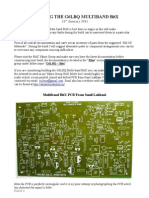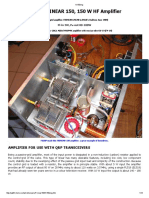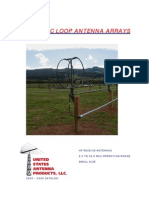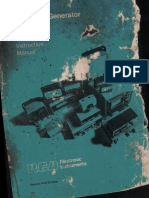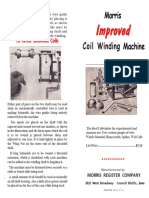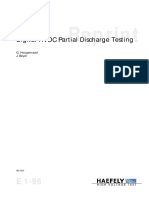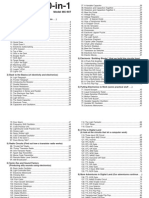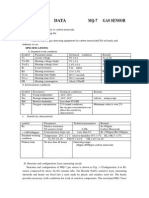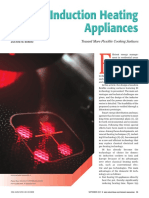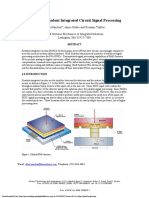New PA For Yaesu Tf101
New PA For Yaesu Tf101
Uploaded by
Federico LavolpeCopyright:
Available Formats
New PA For Yaesu Tf101
New PA For Yaesu Tf101
Uploaded by
Federico LavolpeOriginal Title
Copyright
Available Formats
Share this document
Did you find this document useful?
Is this content inappropriate?
Copyright:
Available Formats
New PA For Yaesu Tf101
New PA For Yaesu Tf101
Uploaded by
Federico LavolpeCopyright:
Available Formats
Hints & Kinks
Edited by Bob Schetgen, KU7G Senior Assistant Technical Editor
This hint is a gem from the mines of South Africa! It tells how to resurrect old Yaesu FT-101s with 6146 finals. Thanks to Radio ZS 1 and the South African Radio League for letting us reprint it here.Ed.
A NEW LIFE FOR YOUR FT-101 Many amateurs who were active in the 1970s were proud owners of Yaesus FT-101, a set that gave Yaesu a good name in the amateur fraternity and is still in use by many amateurs around the world. If we look at the design of the early FT-101s, one of its drawbacks is the choice of low-cost TV sweep tubes in the output stage. Namely, a pair of 6JS6As and later, 6JS6Cs. These tubes were designed as highpower amplifiers at 20 kHz, for use in TV horizontal sweep circuits. Yaesu used them in FT-101s purely for their availability and low cost, whilst their opposition, Trio/ Kenwood, opted for the superior 6146B tubes (S2001), which were specifically designed for RF application, in their TS-510, TS-515 and the TS-520. (Yaesu used 6146s the FT-101ZDs, which were more like baby FT-901s than FT-101s.Ed.) Today, however, the cost of 6JS6Cs is prohibitive, if you can find them, and many FT101s have been retired due to the high replacement cost of these tubes. Far-superior 6l46B tubes are available at a moderate cost, if not in most junk boxes. In the October 1996 Issue of Radio ZS, my article on the modification of the FT-200 to take 6146s was published. In it, I mentioned that it should also be possible to modify the FT101 to take the same tubes, but I did anticipate a slight drop off in output power due to the lower plate voltage in the FT101, which is around 650 V. Recently, I was given a Yaesu FT-101B for repair. After sorting out the many problems, mostly inflicted by amateurs who should not be allowed to take off the covers of amateur equipment, I found that the transmitter output was down to a couple of watts. I therefore decided that the set was a prime candidate for the modification. Before tackling this task, I fitted a 0.01-F capacitor in series with C13 as a precaution. This 80-pF capacitor often becomes leaky, destroying the final tubes. A brand new set of 6JS6s was installed temporarily, just to check that the alignment was correct and the output power was 100 W.
mains supply and remove the final tubes. Remove the bottom cover and screening plate over the PA and driver section. Locate the two 12-pin sockets and unsolder R14 (100 ), L4, C16, R12 and the black coaxial cable inner wire from the tube sockets. Unsolder all the ground connections, decoupling capacitors and the blue heater wires. Unscrew the four Phillips screws and remove the tube sockets. Fit two octal sockets with the keyway facing to the chassis center and wire the sockets as shown in Figure 1A. Use the decoupling capacitors from the old sockets, between where indicated with
an asterisk and the closest ground point. These capacitors have been left off the pictorial for clarity, but are shown in the schematic diagram, Figure 1B. As the 6146Bs require a greater screen-grid voltage than the original tubes, one must trace the orange wire from R14 (100 ) to the feedthrough capacitor (C35) and disconnect it from this point. Then connect it to a different feed-through capacitor, C30, which is the 300 V line for the 12BY7A driver tube. Due to the lesser interelectrode capacitance of the 6146B tubes, two circuit modifications are necessary. In the original
(A)
Getting Down To It
Disconnect the power lead from the
1
(B) Figure 1(A) a pictorial of the FT-101 PA compartment. (B) a schematic of the FT-101 PA circuit.
R. Davis, ZS1J, A New Life for Your FT-101, Radio ZS, August 1998, pp 12-13.
68
May 1999
design, the permeability-tuned coil in the plate circuit of the 12BY7A, T103, is resonated on 10 meters using the input capacitance of the final tubes. Because this capacitance has now been reduced by almost 25 pF, we must compensate for the lost capacitance by introducing a small variable capacitance across T103. Remove the two screws securing the circuit board with the trimmer capacitors, TC6 to TC10, to expose the terminals of coil T103. Solder a 20-pF trimmer capacitor across the two terminals and replace the trimmer board, but leave the screws loose.
Neutralizing Capacitance
The last modification is to reduce the neutralizing capacitance. Remove the 100-pF capacitor, C125, which is in the PA compartment and is connected between the top of the plate choke and the variable neutralizing capacitor. Replace this capacitor with a 2-pF capacitor and adjust the neutralizing capacitor to minimum capacitance from below the chassis. The set is now ready for testing, switching and final alignment. Before switching it on, adjust the bias control fully counterclockwise. This control can be found on board PB-1314 (Regulation and Calibration Unit). With the 6146Bs installed in their sockets, the plate connectors attached and the top screen fitted, power up the set and adjust the bias control for 60 mA in the SSB mode, but with no transmit audio. Switch the set off, turn it upside down and remove the two screws securing the trimmer board. Being careful not to short the board to the chassis, switch the power on and tune the set on 28.000 MHz with the preselector control at the beginning edge of the 10-meter mark. With an insulated alignment tool, adjust the installed trimmer across T103 for maximum drive, being very careful not to touch the loose trimmer board because there is high voltage on these components. This adjustment must be combined with the alignment instructions on page 25, section (3) paragraph two in the original instruction manual. Although no further alignment should be necessary on the other bands, the set should be checked for power output on all bands. Check and if necessary, adjust the neutralization as on page 24 of the manual. If all modifications have been done correctly, you should have in excess of 100 W output on all bands.Roger Davis, ZS1J, PO Box 1099, Plettenberg Bay, 6600, Republic of South Africa
Figure 3A diode string lowers 16 V solararray voltage for use by radio and batteries.
Figure 2A small stick with connector sealant can pick up or hold a multitude of objects. Its a big help when starting threads.
CRAMPED QUARTERS OVERCOME WITH BAMBOO SKEWER AND STICKY COAXIAL WATERPROOFING GOOP! Have you ever been faced with the need to get some small parta screw, a nut or a washerinto or out of an inaccessible spot? Well, your troubles are over! One of the many items in my workshop
is a bundle of bamboo skewers that are meant for cooking kabobs on the grill. These skewers are about 1/16-inch in diameter and eight inches long with a point on one end. I use them for everything from cleaning melted solder out of a hole (for resoldering) to miniature dowels. Now I have found a further use for them! One day I was trying to put a small star lock washer onto a bolt located far down inside my power supply. I tried long-nose pliers but to no avail. Because the pliers handles interfered with everything, I was continually dropping the washer into the works. I know that a magnetic wand sometimes works well, but it also requires that the object you are seeking is ferrous. (Besides, I dont have such a device.) So on that lucky day I was casting my eyes around the shop for some other means (easy and simple), when I spied my roll of sealing tape (RadioShack #278-1645) designed to seal coaxial connectors. Remembering how sticky that stuff is, I put a small glob of it on the flat end of a skewer and my problems were over. I just picked up the star washer with the glob and placed it down into the close confines of my power supply (See Figure 2). I later found that you can pick up good-sized screws and nuts even up to 1/2-inch itemswith the same procedures and you can start the threads by turning the skewer. This works on screws with either Phillips or slotted heads. It also works on wood, plastic, mica, glass, aluminum, etc. Boy is that stuff sticky! Because space is at a premium in my shop and because storage and retrieval is
becoming more difficult, I just throw away the skewer tool when I am finished. It is so cheap that I can make myself a new one when the next occasion arises.Glenn E. Yingling, W2UW, PO Box 62, Newark Valley, NY 13811-0062
A BACKPACKING SOLAR SUPPLY For backpacking, I use two small solar panels with 16 V, 0.290 A output. Paralleled, they easily produce over 0.5 A. (See Figure 3.) Isolation diode D1, plus dropping diodes D2, D3 (and as many as required) may be most any diode with a rating of 1 A at 50 PIV or more. RadioShack #276-1143 (3 A, 200 PIV) will put the charging in a good range for most batteries. To determine how many diodes to use, you should check the charge available in full sunlight. When you obtain a suitable charge rate with the QRP rig connected, the voltage is correct. I built the prototype for friend WA5TYJ, who reports that it performs nicely. By using the battery for energy storage, ample power is available to operate his QRP rig. The solar panels can charge the battery and power the rig simultaneously when the sun is out. The battery takes over whenever there is insufficient sunlight.A. W. (Bill) Edwards, K5CN, 456 Glenmore St, Corpus Christi, TX 78412-2827
Hints and Kinks items have not been tested by QST or the ARRL unless otherwise stated. Although we cant guarantee that a given hint will work for your situation, we make every effort to screen out harmful information. Send technical questions directly to the hints author. QST invites you to share your hints with fellow hams. Send them to Attn: Hints and Kinks at ARRL Headquarters (see page 10), or via email to rschetgen@arrl.org. Please include your name, call sign, complete mailing address, daytime telephone number and e-mail address on all correspondence. Whether praising or criticizing an item, please send the author(s) a copy of your comments.
May 1999
69
You might also like
- Marantz Pm7004 N K SM v01 - 2Document66 pagesMarantz Pm7004 N K SM v01 - 2dierickx.handNo ratings yet
- Build Instructions For The Indo-Ware SSB 6.1 Transceiver (Final Version) Written by G0CWA August 2016Document71 pagesBuild Instructions For The Indo-Ware SSB 6.1 Transceiver (Final Version) Written by G0CWA August 2016fox7878No ratings yet
- G6LBQ Multiband BitX ManualDocument36 pagesG6LBQ Multiband BitX ManualAndrei Avirvarei83% (6)
- Building and Operating The Digital Sony SRF-39Document4 pagesBuilding and Operating The Digital Sony SRF-39englagra0% (1)
- Sony Sdm-hx73 Sdm-hx93 Service ManualDocument40 pagesSony Sdm-hx73 Sdm-hx93 Service Manualum1668No ratings yet
- Multipurpose Programming CableDocument7 pagesMultipurpose Programming CableJozo ĆurčićNo ratings yet
- 0207040Document3 pages0207040Munte si mareNo ratings yet
- Vacuum Tube Volt Meter VTVM How It Works How To Use It Rhys Samuel 1956 254pDocument224 pagesVacuum Tube Volt Meter VTVM How It Works How To Use It Rhys Samuel 1956 254pHugo BarrosNo ratings yet
- HF High Power Pa Pl519Document13 pagesHF High Power Pa Pl519Jozo ĆurčićNo ratings yet
- Most All Alinco ModsDocument136 pagesMost All Alinco Modscp6ag67% (3)
- KATS Universal ProgrammerDocument6 pagesKATS Universal ProgrammerdorudNo ratings yet
- Diode Turn-On and Off TimeDocument50 pagesDiode Turn-On and Off TimeUma Kalyani100% (1)
- Reflex MW AM ReceiverDocument3 pagesReflex MW AM ReceiverCarlos Molins LopezNo ratings yet
- Aperiodic Loop Antenna ArraysDocument36 pagesAperiodic Loop Antenna Arraysbayman66No ratings yet
- Q 200109Document180 pagesQ 200109Anonymous 60esBJZIjNo ratings yet
- Long Biquad Yagi TemplateDocument4 pagesLong Biquad Yagi TemplateHernan Dario Garcia BastidasNo ratings yet
- Drake L7 LINEAR AMPLIFIERDocument37 pagesDrake L7 LINEAR AMPLIFIERTihomir MitrovicNo ratings yet
- The Xtal Set Society NewsletterDocument17 pagesThe Xtal Set Society Newsletterhds0405No ratings yet
- Triplett 630A Meter ManualDocument29 pagesTriplett 630A Meter Manualjdawson02No ratings yet
- Crumar Bit 01 Service Manual PDFDocument13 pagesCrumar Bit 01 Service Manual PDFFlaco Depaulo Carlos100% (1)
- All Band Large LoopDocument4 pagesAll Band Large Loopbearbullride10100% (1)
- RAF Aircraft Radio Receiver Marconi R1155 History and DataDocument2 pagesRAF Aircraft Radio Receiver Marconi R1155 History and DataCorsair58100% (3)
- Dual Rhombic Vhf-UhfDocument4 pagesDual Rhombic Vhf-Uhfmiguelpaltino100% (1)
- MFJ-941D Versa Tuner Ii InstructionsDocument4 pagesMFJ-941D Versa Tuner Ii InstructionsKI4JMYNo ratings yet
- Vfo With SiDocument16 pagesVfo With SiToplician AdrianNo ratings yet
- Another Simple MK484 RadioDocument2 pagesAnother Simple MK484 Radiorftek100% (2)
- Radio Bucur.2Document1 pageRadio Bucur.2Bunea ConstantinNo ratings yet
- Ardf-Reciever Fox-801 (Dl4cu) - enDocument7 pagesArdf-Reciever Fox-801 (Dl4cu) - enag1tatorNo ratings yet
- 1T4 Short Wave Three R&E 0351 10pDocument10 pages1T4 Short Wave Three R&E 0351 10pNorman Bourassa100% (2)
- Electronic Stethoscope-2Document2 pagesElectronic Stethoscope-2subhadeep41No ratings yet
- RCA WR-50B Signal Generator Instruction ManualDocument44 pagesRCA WR-50B Signal Generator Instruction ManualReed Jonathan100% (1)
- Antentop 2014-01Document120 pagesAntentop 2014-01Black OnionNo ratings yet
- AOR3000 All ModsDocument22 pagesAOR3000 All ModsdomisoftNo ratings yet
- Morris Coil Winder Page OneDocument1 pageMorris Coil Winder Page OnemcantosNo ratings yet
- The New Carolina WindomDocument13 pagesThe New Carolina WindomAlexander Nuñez CastilloNo ratings yet
- Lion Cub Scouts Two Tube Radio SetDocument9 pagesLion Cub Scouts Two Tube Radio SetRandom73No ratings yet
- Quad 34 Service Data ManualDocument37 pagesQuad 34 Service Data ManualciohaniNo ratings yet
- 2014 Handbook Supplemental FilesDocument13 pages2014 Handbook Supplemental FilesIñaki PerezNo ratings yet
- Almanah87 PDFDocument189 pagesAlmanah87 PDFAlinSintimbreanNo ratings yet
- Atlas-210X ManDocument57 pagesAtlas-210X ManJonathan RichardsonNo ratings yet
- Manual All MultizetDocument9 pagesManual All MultizetalbundNo ratings yet
- Tektronix CookbookDocument23 pagesTektronix CookbookbiotekyNo ratings yet
- 3 77 PDFDocument68 pages3 77 PDFviatr0nic100% (1)
- Best Receiver Eddystone Ever Built - The EC958Document34 pagesBest Receiver Eddystone Ever Built - The EC958rotexNo ratings yet
- FT-817 Mods: Battery Mod For ft-817Document43 pagesFT-817 Mods: Battery Mod For ft-817Arturo MejiaNo ratings yet
- Test Report Uniden Bearcat 980 ENGDocument86 pagesTest Report Uniden Bearcat 980 ENGStephanie Hall100% (1)
- All The Way With QRPDocument3 pagesAll The Way With QRPBenjamin DoverNo ratings yet
- Atwater Kent Manual 1931 OcrDocument45 pagesAtwater Kent Manual 1931 Ocrpete leoniNo ratings yet
- Aa3Rl - Transmission Line Calculator: Input Data: Output DataDocument5 pagesAa3Rl - Transmission Line Calculator: Input Data: Output DataNd ReyesNo ratings yet
- Harbuch Electronics Pty LTD: Input TransformersDocument4 pagesHarbuch Electronics Pty LTD: Input Transformersattapapa100% (1)
- Radio TV Experimenter 1965-02-03Document132 pagesRadio TV Experimenter 1965-02-03mplennaNo ratings yet
- ESR Capacitor Meter Project PDFDocument22 pagesESR Capacitor Meter Project PDFzoran_stev100% (1)
- NIKIDocument9 pagesNIKICostinNo ratings yet
- Tramp-8 8 Band CW Transceiver: Dl-Qrp-AgDocument44 pagesTramp-8 8 Band CW Transceiver: Dl-Qrp-AgCarlos IrigoinNo ratings yet
- Antenna Tuner G3WMEDocument2 pagesAntenna Tuner G3WMEfox7878100% (3)
- Dentron MLA-2500 GI7B Modification Procedure 3Document27 pagesDentron MLA-2500 GI7B Modification Procedure 3david bonilla pinoNo ratings yet
- "Dynamutt" Driver Board: For The Dynaco St-70Document15 pages"Dynamutt" Driver Board: For The Dynaco St-70azornNo ratings yet
- A Look at The Yaqin MC100BDocument24 pagesA Look at The Yaqin MC100BRoi Rey100% (1)
- Apex - 460 - Tube Condenser Mic ModsDocument48 pagesApex - 460 - Tube Condenser Mic ModsTom VenagliaNo ratings yet
- AM Receiver: Home Analysis Help Media Links PracticalDocument10 pagesAM Receiver: Home Analysis Help Media Links PracticalĐinh Văn HiếuNo ratings yet
- Interruption Phenomena and Testing of Very Large SF6 Generator Circuit-BreakersDocument11 pagesInterruption Phenomena and Testing of Very Large SF6 Generator Circuit-Breakersdes1982No ratings yet
- HakkoDocument87 pagesHakkoAdrian MargescuNo ratings yet
- Experiment: #3: Nand and Nor Gates: Marlon Myers Digital Control EMT1250 Professor: Prof. PatrickDocument8 pagesExperiment: #3: Nand and Nor Gates: Marlon Myers Digital Control EMT1250 Professor: Prof. PatrickShubham AshtekarNo ratings yet
- Electrical Theory Exam (4 Hours) : Suggested Study MaterialsDocument3 pagesElectrical Theory Exam (4 Hours) : Suggested Study Materialsasw04No ratings yet
- Reprint: Digital HVDC Partial Discharge TestingDocument6 pagesReprint: Digital HVDC Partial Discharge TestingcisnatelNo ratings yet
- BAT54-Series: 200mW SMD Schottky Barrier DiodeDocument4 pagesBAT54-Series: 200mW SMD Schottky Barrier DiodeElvie A. CumbalNo ratings yet
- Project Report For Arduino Based Car Parking AssistanceDocument9 pagesProject Report For Arduino Based Car Parking AssistanceShubham SrivastavaNo ratings yet
- En 647 Distributed Generation and MicrogridsDocument23 pagesEn 647 Distributed Generation and MicrogridsSumeet MehardaNo ratings yet
- (ELEC2420) (2015) (F) Final Brilkjdd 93583Document15 pages(ELEC2420) (2015) (F) Final Brilkjdd 93583Outis WongNo ratings yet
- Expr4 EelabDocument6 pagesExpr4 EelabCenk DenizNo ratings yet
- MX907Document3 pagesMX907João Manuel LopesNo ratings yet
- Technical Data Mq-7 Gas Sensor: FeaturesDocument3 pagesTechnical Data Mq-7 Gas Sensor: FeaturesCatur Mei RadhickaNo ratings yet
- A4988 DatasheetDocument20 pagesA4988 Datasheetun_diletanteNo ratings yet
- Dica Lab ManualDocument88 pagesDica Lab ManualRaghavendra RaghavaNo ratings yet
- Induction CookingDocument13 pagesInduction CookingMarco Fajardo100% (1)
- Optical FIber LabDocument5 pagesOptical FIber LabMian Abdul BasitNo ratings yet
- Advanced Readout Integrated Circuit Signal ProcessingDocument11 pagesAdvanced Readout Integrated Circuit Signal ProcessingOmkar KatkarNo ratings yet
- LF153 LF253 - LF353: Wide Bandwidth Dual J-Fet Operational AmplifiersDocument2 pagesLF153 LF253 - LF353: Wide Bandwidth Dual J-Fet Operational AmplifiersKSNo ratings yet
- Bipolar Transistor BiasingDocument29 pagesBipolar Transistor Biasingmoin_mohdNo ratings yet
- Heater Filament SuppliesDocument4 pagesHeater Filament SuppliesDiego García MedinaNo ratings yet
- Physics Investigatory ProjectDocument9 pagesPhysics Investigatory ProjectAysha HasanNo ratings yet
- Bidirectional Single Stage Grid Connected Inverter For Battery Energy Storage System Project Report Submitted byDocument8 pagesBidirectional Single Stage Grid Connected Inverter For Battery Energy Storage System Project Report Submitted byRamesh RNo ratings yet
- PHYSICAL ONLY CELLS - VLSI - Physical Design For FreshersDocument14 pagesPHYSICAL ONLY CELLS - VLSI - Physical Design For FreshersRA NDYNo ratings yet
- ATM Security With EEPROM and One Time Password With GSMDocument4 pagesATM Security With EEPROM and One Time Password With GSMChandrahasJoshiNo ratings yet
- Starting and Controlof Slip Ring Induction Motors PDFDocument16 pagesStarting and Controlof Slip Ring Induction Motors PDFkubik100% (1)
- VGN Ns100 SeriesDocument22 pagesVGN Ns100 Seriesaldo_suviNo ratings yet
- TM11-2637 Test Set Espey Model 100, 1945Document64 pagesTM11-2637 Test Set Espey Model 100, 1945david_graves_okstateNo ratings yet
- Fundamentals of Electricity ElectronicsDocument455 pagesFundamentals of Electricity ElectronicsXozan100% (1)
- 5 Unit - 5 Field Effect Transistors: Review QuestionsDocument16 pages5 Unit - 5 Field Effect Transistors: Review Questionsashley correa100% (1)


